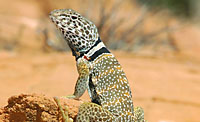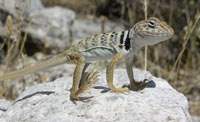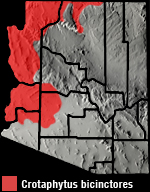Online Field Guide to The Reptiles and Amphibians of Arizona


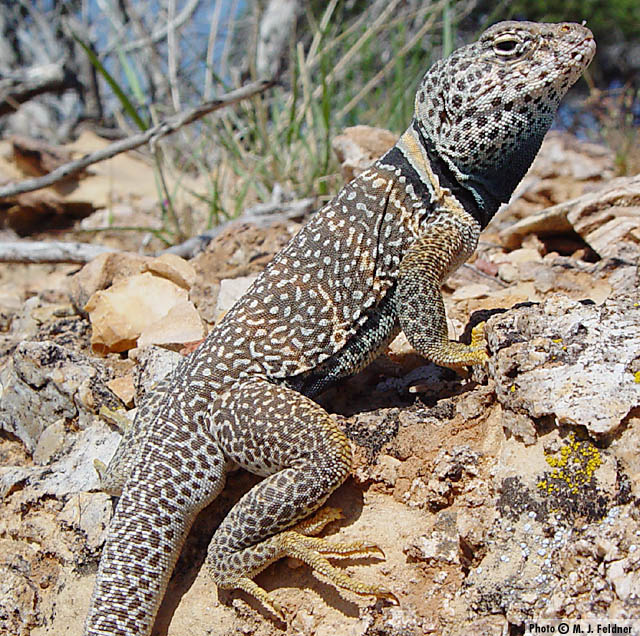
Arizona
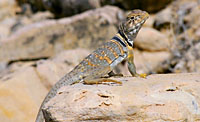 Female. Mohave Co., AZ |
||
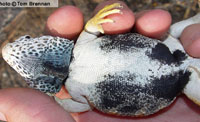 Male Venter. Mohave Co., AZ |
| GREAT BASIN COLLARED LIZARD Crotaphytus bicinctores |
|
|
DESCRIPTION: A medium-sized (up to 108 mm or 4.25″ from snout to vent), plump-bodied lizard with a large head and two distinct, black collar markings on the neck. On males the front collar completely encircles the neck. Coloration is usually gray-brown with faint, soft-edged, yellow or orange crossbands. The feet and limbs are often tinted with yellow-orange and the back is usually marked with many white or cream colored dots. This pattern reverses on the tail and hind limbs becoming gray-brown dots on a light background. The underside is plain and pale. The scales are small and granular. The tail is taller than it is wide distinguishing this lizard from the similar Eastern Collared Lizard and Sonoran Collared Lizard. Males have dark blue-gray to black patches on the throat and groin and a pale stripe running down the top of the tail. Females are duller in color and have orange markings on the sides when gravid. HABITAT: Primarily an inhabitant of Sonoran Desertscrub, Mohave Desertscrub, Great Basin Desertscrub, and Great Basin Grassland. Also enters Interior Chaparral and Great Basin Conifer Woodland communities in some areas. Frequents hillsides, canyons, and slopes with numerous large rocks. Infrequently encountered on relatively flat terrain lacking large rocks. BEHAVIOR: Primarily diurnal. Occasionally evening-crepuscular. It often basks in the mid-morning sun atop large rocks which serve as lookouts for prey. It hibernates during the cold months of winter and late fall. At top speeds this lizard lifts the forelimbs off the ground and runs on its hind limbs. Like other collared lizards this lizard is territorial and aggressive to other males. It does not hesitate to bite when captured and it can easily draw blood with its powerful jaws. Unlike many of our lizards collared lizards can not cast off and regenerate the tail. DIET: It uses its powerful jaws to capture insects, spiders, and lizards. It also occasionally eats some plant material. REPRODUCTION: The Great Basin Collared Lizard lays a clutch of up to 7 eggs in spring or summer. It hybridizes with the Eastern Collared Lizard in areas where their ranges meet. By Thomas C. Brennan Brennan, T. C., & A. T. Holycross. 2006. A Field Guide to Amphibians and Reptiles in Arizona. Arizona Game and Fish Department. Phoenix, AZ Brennan, T. C., & A. T. Holycross. 2005. A Field Guide to Amphibians and Reptiles of Maricopa County. Arizona Game and Fish Department. Phoenix, AZ |
|
Visit Partners in Amphibian and Reptile Conservation:


HOME
Copyright © 2023, Arizona Game and Fish Department. All rights reserved.
If you make use of the textual contents of this site in reports, publications, etc. please cite and credit the author(s) and photographer(s). All photos on this website are copyrighted. However, those found in the species account section may be used for any noncommercial scientific, educational, or conservation purposes provided that photographs are not altered and continue to bear the copyright symbol and name of the photographer. Please contact the photographer regarding commercial use of copyrighted photographs.










